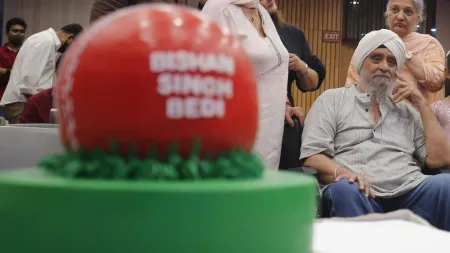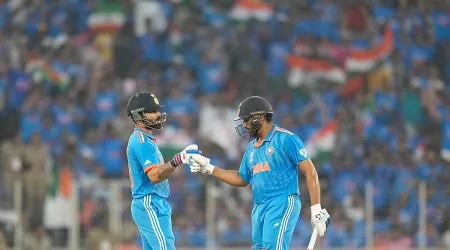- India
- International
India vs Australia ODIs: Amir, Shaheen, Boult, Jansen and now Starc: Nightmares continue against left-arm seam
The ball bending into the right-handers from the angle has been kryptonite for batting superstars
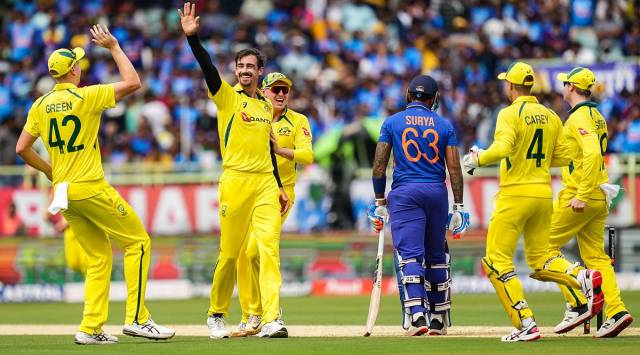 Australian bowler Mitchell Starc celebrates with teammates after the wicket of Indian batter Suryakumar Yadav. (PTI)
Australian bowler Mitchell Starc celebrates with teammates after the wicket of Indian batter Suryakumar Yadav. (PTI)Even before Suryakumar Yadav faced his first ball in Vizag, against Mitchell Starc, he knew what the first ball would be. It would be on the fuller side of the good-length band, land on middle-and-leg stump, and curl onto his pads. Tossing the ball between his palms, at the top of his Amazonian run-up, Starc too knew what his first ball should be. It should land around middle and leg stump and bend into the batsman’s pads.
It’s how Starc had nailed Yadav in Mumbai too, and it’s how Starc would nab him in Vizag. It could be how he would twinkle him out in Chennai as well. The trap is predictably simple — distressingly, it applies for most of India’s top order batsmen against in-swing-armed left-arm seam and swing merchants. So much so that in this series alone, Starc’s late-swerving in-swingers have devoured Yadav twice, and Kohli and Rahul once apiece. Of his eight wickets so far in the series, the in-swinger has left its skull-faced stamp on four batsmen.
There exists a fatalism about it. Yadav knew what Starc would do, yet did not know how to avert the danger. The ball curved like a falling star, past a defenceless straight bat, to hit the flap of his front pad.
In fairness, Yadav did make some adjustments in Vizag. This time, he was conscious of not planting his front foot across the crease, but rather down the ground so that the bat need not come around the front pad, a recurring undoing of most Indian batsmen against left-handers’ in-swingers.
His bat subsequently was coming down from first slip, or a fraction wider, and not third slip as it did in Mumbai, But here, he seemed over-bothered about his alignment and was stuck in the crease. He was still moving — only the heel of the left foot was on the ground and the front leg was angled — when the ball hit him. This can happen when a batsman is spooked by a ball, when it has begun to haunt him even when he is not batting. He knows the flaw, knows the solution, but his muscle memory has not yet internalised the new response pattern.

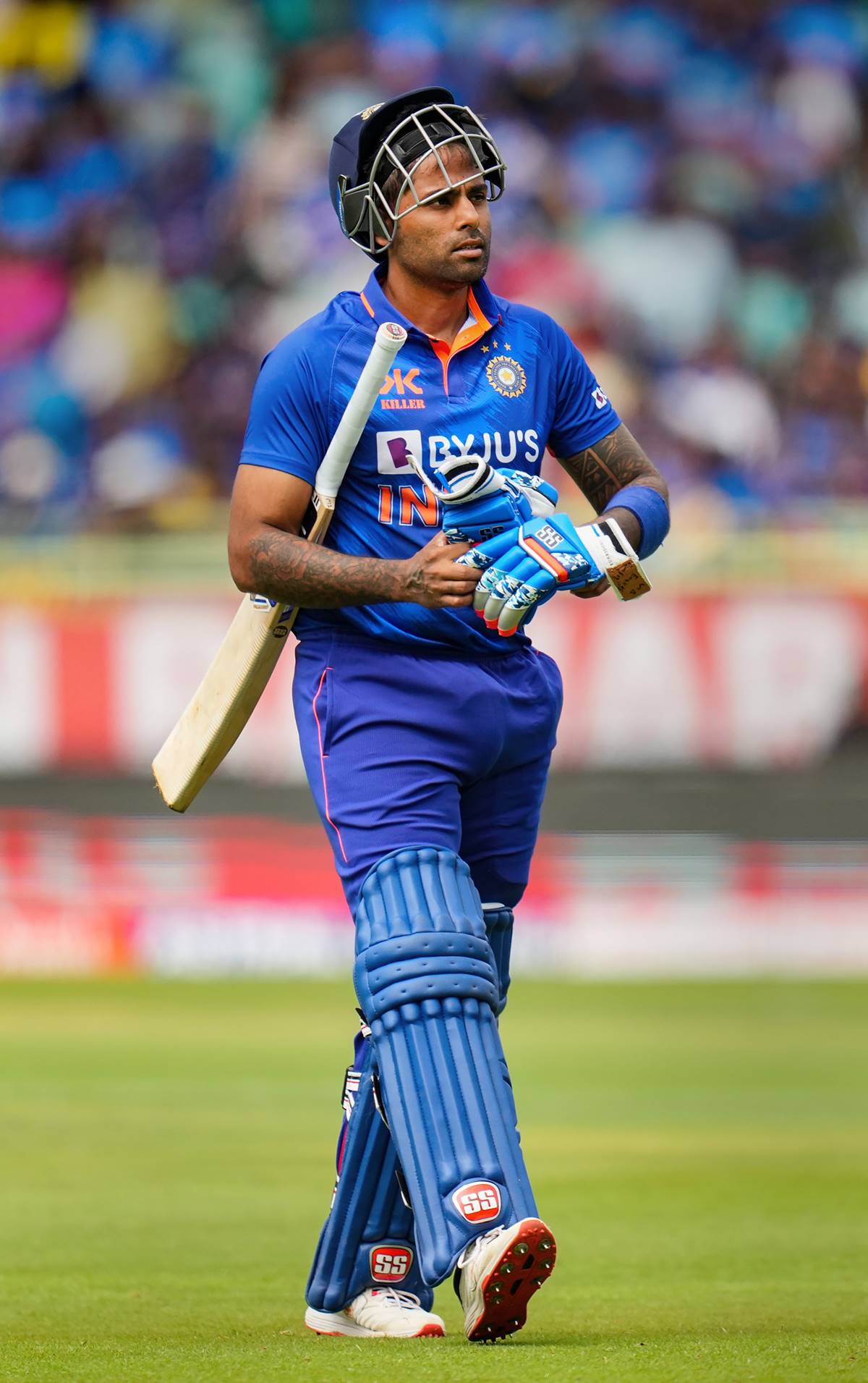 Suryakumar Yadav walks off the field after being dismissed. (PTI Photo)
Suryakumar Yadav walks off the field after being dismissed. (PTI Photo)
Rather, it was KL Rahul’s dismissal that epitomised the flawed techniques of Indian batsmen against the late-bending south-pawed in-swingers. He was far too across, the upper body stooping, lower body flailing, and the bat descending from third slip to counter a ball that landed on middle stump and seamed in to blast his pads. He fell over. He misjudged that the ball would have probably gone down the legside and sought a review, but without factoring in his exaggerated shuffle.
Tough proposition
No doubt that an in-swinger from a left-handed quick is difficult to repel. It almost blindspots a right-hander. The ball is pouncing from the corner of the eye, the natural instinct is to shuffle across with the line, and then when the ball nips back, batsmen find themselves too far across and the bat has to come across the front pad. The movement impedes batsmen from presenting the full face of the bat to the ball. A less quick seamer could offer them wriggle room —though Indian batsmen have struggled against Reece Topley and Obed McCoy as well — but not against high-pace operators like Starc and Shaheen Shah Afridi.
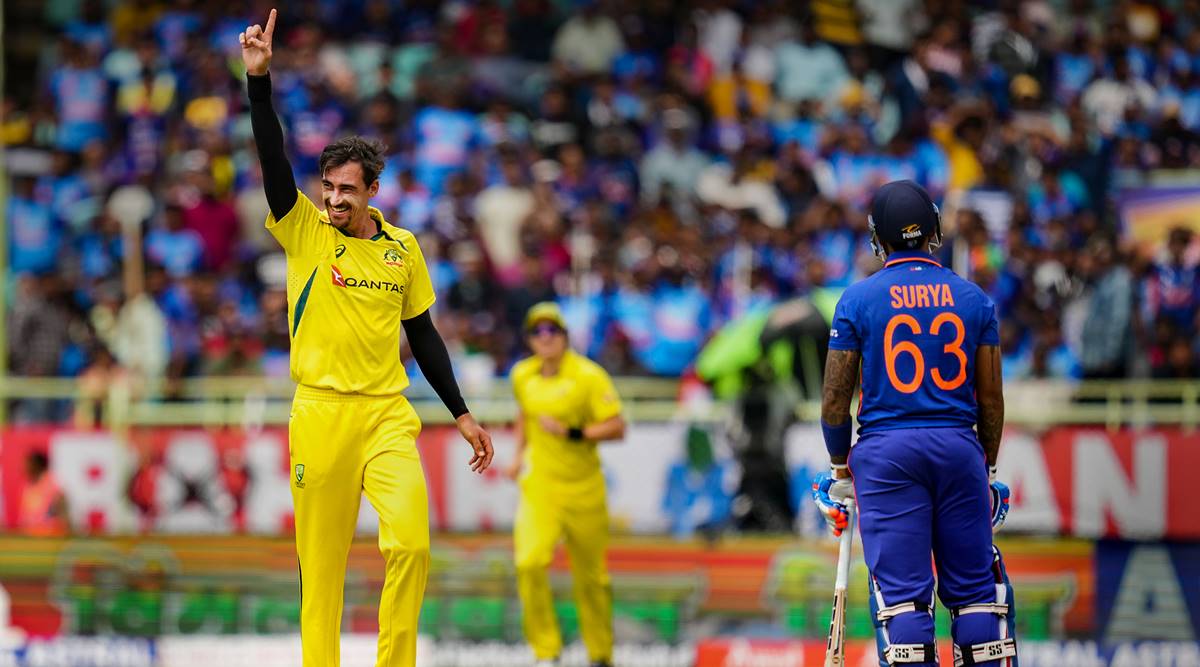 Mitchell Starc and Suryakumar Yadav during the second ODI cricket match between India and Australia, at Dr. Y.S. Rajasekhara Reddy International Cricket Stadium in Visakhapatnam. (PT)
Mitchell Starc and Suryakumar Yadav during the second ODI cricket match between India and Australia, at Dr. Y.S. Rajasekhara Reddy International Cricket Stadium in Visakhapatnam. (PT)
But what hastens their downfall is their thrusting left foot, and once it gets planted across the line of the ball, they are then over-dependent on their wrists and hands to bail them out of trouble. The head and the hip go off-kilter, in a sense that they end up locking the body completely. The lower body is going in one direction and when the ball comes in, the upper body has to rotate to get the bat across. But when the front leg comes down the pitch rather than across, it automatically helps the shoulder lean into the line of the ball, which invariably means better control and a fuller blade. It was Yadav’s half-baked method that backfired against Starc.
Where Yadav failed, Kolhi succeeded in Vizag. At the Wankhede, Kohli too committed the mistake of planting his front foot half-across and looking to whip Starc to the legside. But in Vizag, he opened up his stance slightly and was inclined to defend or check-drive him down the ground.
Historical problem
Even the finest of India’s batsmen have struggled — watch two balls before Wasim Akram’s Chepauk corker to Rahul Dravid in 1999, when he was ludicrously fortunate to have survived. So did VVS Laxman in that series. But they solved the glitches, unlike the present bunch, for whom the flaw is as pronounced as it was that 2017 June evening at The Oval when Mohammad Amir orchestrated a top-order meltdown.
A raft of others — often in crunch games — have exploited this flaw of India’s contemporary batting greats against left-arm pace. The list of left-armed wreckers range from unknowns and rookies to legends and masters, from Starc and Shaheen, to Topley and McCoy, Amir and Trent Boult, to Marco Jansen and Mustafizur Rahman.
Bewilderingly, even right-arm finger-spinners have begun to exploit the vulnerability, like Nathan Lyon and Toddy Murphy in the recent Test series, where they bowled 70 percent of their overs from round the stumps. The ploy, no doubt, owes to the big-spinning, low-bouncing nature of pitches in the series, but the method turned out to be successful because of Indian batsmen’s propensity to thrust the front foot across, even when looking to defend, like Cheteshwar Pujara in Delhi, or Kohli in the first innings at Indore.
In a sense, bowlers get more thrill from it; in not producing a ball that they have never produced before, but in reproducing the same trick they have performed several times. A joy from repeatability, from inevitability, in the awareness of destiny dwelling in their hands.
So Yadav or Rahul or Rohit Sharma or Kohli would know what Starc’s first ball would be. Starc would also know what his first ball should be. Full on middle and leg, tailing in — the most dreaded ball for India’s contemporary batting greats.
It’s not just Starc…
India vs Pakistan (Oval 2017, Champions Trophy final)
Destroyer: Mohammed Amir
Synopsis: In pursuit of 339, Amir took out Rohit Sharma early with a fiendish in-swinger. Though it was a cross-seam away-goer that gobbled up Virat Kohli, he was wonderfully set up with nip-backers. Often forgotten is his new-ball spell against India in the 2016 Asia Cup final too, when he had both Sharma and Ajinkya Rahane LBW in the first over; both to in-swingers.
India vs Pakistan (Dubai, group game, T20 World Cup)
Destroyer: Shaheen Shah Afridi
Synopsis: In the space of seven balls, he took out openers Sharma and KL Rahul with two glorious in-swingers. The ball to Sharma, the first of the game, was full, quick and bending late to thunder onto his front pad. The one to Rahul was so rapid that he could not get the bat down in time to prevent the ball from disarraying the stumps.
India vs New Zealand (Hamilton, 2019)
Destroyer: Trent Boult
Synopsis: The Kiwi relishes India’s batsmen, having picked up 24 wickets at an average 24 in ODIs, 12 at 17 in T20Is and 41 at 28 in Tests, but nowhere was he as devastating as he was in Hamilton, where he snared five wickets for 21 runs, three of them with in-swingers. He also hurt India at the 2019 World Cup, when he consumed Kohli with a trademark in-swinger.
India vs England (Lord’s 2022)
Destroyer: Reece Topley
Synopsis: None of his six wickets were bargained with the big in-swinger. He rarely swung or seamed the ball back in. But he would make the ball hold the line, create awkward bounce and probe the channel. The combination was all that the Indian batsmen required to fold up.
Get latest updates on IPL 2024 from IPL Points Table to Teams, Schedule, Most Runs and Most Wickets along with live score updates for all matches. Also get Sports news and more cricket updates.



















